LIGHTING FOR DIFFERENT AREAS
Living and family rooms, dining rooms, kitchens, bedrooms, bathrooms, entries & hallways, garages, exterior.
Lighting makes a home at night. It can make rooms more inviting and dramatic and can be used to accentuate features that are not as noticeable by day.
Living and Family Rooms
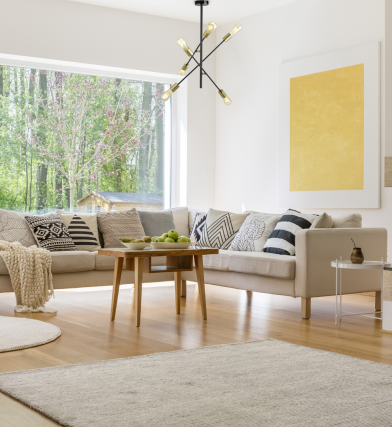 Living and family rooms are used for different purposes and so, require different or variable lighting. In these rooms people may be watching TV, reading, just relaxing or doing some sort of hobby, such as sewing. Each of these different activities requires a different kind of lighting and it is a good idea to have different lights controlled by their own switches so variation can be achieved.
Living and family rooms are used for different purposes and so, require different or variable lighting. In these rooms people may be watching TV, reading, just relaxing or doing some sort of hobby, such as sewing. Each of these different activities requires a different kind of lighting and it is a good idea to have different lights controlled by their own switches so variation can be achieved.
Dimmers are also ideal for providing flexibility in light levels and effects. If you look at the tasks that are undertaken in the living and family rooms you will appreciate why different lighting is needed. Reading and other fine tasks require a higher light level than say, watching TV. For this you will need almost all of the lights on or, a specific task light such as a table or floor standing lamp. When watching TV the room needs to be less well lit but ideally not in total darkness as the stark contrast between the TV and the wall behind it can cause eye strain as the eye has to continually adjust. The answer is to position a light above or near the TV so the wall behind it is lit well. The light should not be too bright as to take attention away from the screen. Nor should it shine onto the screen as it would 'wash out' the picture. Downlights are ideal for this as their lamps are shielded from view. These should be mounted around a metre away from the corners of the room, as well as in the centre so they light the walls. 'Tilt and Turn' downlights are ideal for this as they can be aimed away from the line of sight and also be used to light pictures or other items.
Besides downlights, it is advisable to have other lighting in family and living rooms to create more interesting effects and boost the light level when needed. This other lighting can be wall lights, picture lights or ceiling pendants. The reason for this is to also illuminate the ceiling, which downlights do not do. By doing this, the room can be transformed from a relaxed comfortable mode into a more well lighted functional space. Pictures, souvenirs, professional artifacts or an attractive plant can be highlighted with back-lighting, picture lights or adjustable spotlights.
Dining Rooms
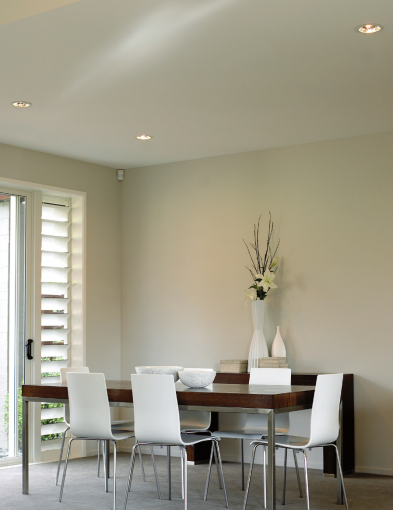 As a general rule of hospitality you and your guests should be able to clearly see the food that is being served. Again, varied lighting, controlled by dimmers, can create a relaxed mood that can set the scene for dinner parties and general dining. Dining tables are also used for other purposes such as children doing homework, playing games or writing. For these activities there will need to be more light than for dining and so functional lighting as well as stylish, mood lighting will also be needed.
As a general rule of hospitality you and your guests should be able to clearly see the food that is being served. Again, varied lighting, controlled by dimmers, can create a relaxed mood that can set the scene for dinner parties and general dining. Dining tables are also used for other purposes such as children doing homework, playing games or writing. For these activities there will need to be more light than for dining and so functional lighting as well as stylish, mood lighting will also be needed.
Decorative lights or pendants are ideal for lighting dining tables and these should be suspended around a metre above the table to provide enough light without causing too much glare. As an alternative to suspended lights downlights can be used, aimed straight down onto the table, these provide lots of light and with little glare.
If combining a pendant with downlights ensure that they are mounted far enough away from each side of the centre light so as not to cause shadows, yet still provide even illumination on the table.
Again, wall lights are effective in brightening up the room or creating a softer more relaxed mood when dimmed or lower wattage fixtures are selected.
Kitchens
 The kitchen primarily is a work area and needs lighting to suit. However, kitchens are also used for entertaining and some dining.
The kitchen primarily is a work area and needs lighting to suit. However, kitchens are also used for entertaining and some dining.
A variation in lighting is advisable. Downlights, track lighting, suspended strip lighting, recessed strip or furniture lights and pendants are all ideal Lighting options for a Kitchen.
Do not under do kitchen lighting as too little lighting can cause shadows, which may be unsafe where sharp knives are used. You should also position lighting above or near cook tops (where practical) so cooking and preparation of meals can be well seen. Utility lights, such as LED striplights, are the best solution for mounting in pantries and below wall-mounted cupboards where worktops would otherwise be shaded from the overhead lighting. Select from purpose made cabinet lights specially designed for installing into cupboard and cabinets which provide both functional and effect lighting.
Soffits, under breakfast bars and other concealed places such as tops of cupboards are an ideal place to locate indirect or hidden lighting that provides a decorative effect and adds to the general ambient lighting.
Bedrooms
 Although sleeping is done mostly in the dark the bedroom is also a place for dressing and getting ready in the evenings and in the mornings or to sit and read a book.
Although sleeping is done mostly in the dark the bedroom is also a place for dressing and getting ready in the evenings and in the mornings or to sit and read a book.
One rule for bedroom lighting is to avoid placing downlights directly over the bed because they are a direct source of glare when lying down. As people often read in bed it is useful to have table lamps, wall lights or pendant lights next to the bed. Alternatively, wall lights that throw most of their light upward should be mounted on the wall above the bed head. These lights should be switched from near the bed for convenience and ideally by a two-way switch at the doorway. Besides bed head lighting for reading, other general lighting will be required, downlights, celing lights or pendant lights are all suitable options. Dimmers are ideal for controlling lights in the bedroom as they allow lights to be turned on at a low level to avoid hurting the eyes when they are adapted to darkness when getting up in the middle of the night. or tanstioning in the morning and evenings
In closets and walk-in wardrobes a reasonably high light level is needed so that items can be recognised easily. High wattage downlights striplights and cleverly placed cabinet lighting are good options here to ensure you can easily find what you need.
Bathrooms
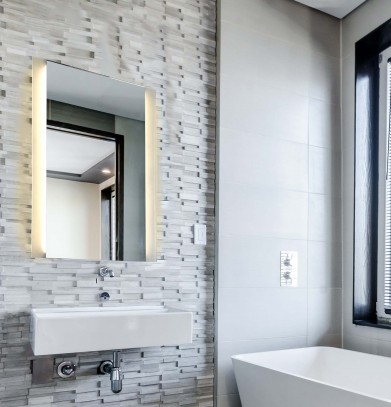 Bathrooms need to be reasonably well lit and a single, centered pendant or ceiling button is not the right answer. This is because standing in front of the mirror would create unflattering shadows, as would downlights. This is why there is such a comprehensive range of utility and mirror lights available.
Bathrooms need to be reasonably well lit and a single, centered pendant or ceiling button is not the right answer. This is because standing in front of the mirror would create unflattering shadows, as would downlights. This is why there is such a comprehensive range of utility and mirror lights available.
When looking in a mirror you need light to shine on your face evenly from in front of you. This is best done with striplights or long wall lights or 'Hollywood' lights. Other, more general lighting is also needed and this can be in the form of pendants, ceiling buttons or downlights. It is also a good idea to have a downlight over the bath or shower. There are electrical safety issues relating to lighting in bathrooms that affects the choice and location of fittings. The IP rating (ingress protection) which denotes its suitability to be submerged or close to water sources or not, stipulates where fittings can be located within the bathroom.
Entries and Hallways
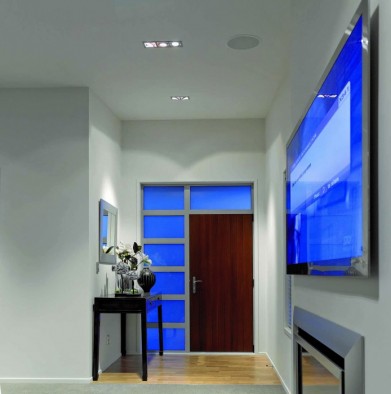 Hallway lighting should be bright enough to light stairs, corners and steps or other potential hazards. Lighting should be bright enough to distinguish different colours but does not have to be not light enough to ready by.
Hallway lighting should be bright enough to light stairs, corners and steps or other potential hazards. Lighting should be bright enough to distinguish different colours but does not have to be not light enough to ready by.
The entrance into the home is an important area of lighting that is often neglected. As visitors enter the home at night it is this area they see first and gain their first impression from. Entries and hallways can benefit from a variety of different lighting. Homes with large imposing foyers can be lit with suitably imposing chandeliers or pendants that will impress at first sight. Hallways are often lined with pictures that can be shown off with picture lights, adjustable downlights or other accent lighting. These options are often ignored, despite the entry being the place where people are usually first welcomed into the home. Also think about the use of the hallway over night you may want to place low light recessed wall lights, perfect for when you want to wind down in the evening or need to dash to the kids in the middle of the night and don't want to be stunned by bright light.
Garages
Garages do not have to be lit for effect but are often underlit in general. A central light point in a garage is of limited use if cars are parked or working tasks are performed there. Functional lighting is needed in garages and usually task lighting as well. For garages LED strip lighting or wall/ceiling buttons are the best option as they provide high levels of direct light over large areas.
Exterior
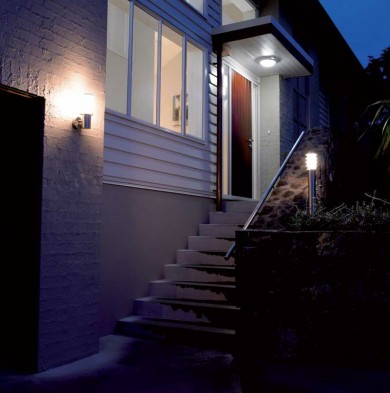 Thanks to our climate we are able to spend a lot of time outdoors in the evenings. This can be made much more enjoyable with good exterior lighting, which also adds to making a more secure home environment too. The key to good exterior and garden lighting is variety and subtly. Bring your home to life highlighting its architectural features such as beams, textured facades, large trees, garden walls and sculptures.
Thanks to our climate we are able to spend a lot of time outdoors in the evenings. This can be made much more enjoyable with good exterior lighting, which also adds to making a more secure home environment too. The key to good exterior and garden lighting is variety and subtly. Bring your home to life highlighting its architectural features such as beams, textured facades, large trees, garden walls and sculptures.
From a lighting design perspective the exterior can be considered in three height zones: low down, medium and high up. At high levels lighting spreads over a greater area and floodlights mounted over eaves, or pole top lights, can be used to light a whole garden or driveway. Medium level lighting, such as bulkhead lights, can be used to light smaller, specific or isolated areas. A bulkhead light or bollard above a flowerbed is a good example of this. Also at medium height, lanterns or bulkheads on either side of a front door appear welcoming and allow a clear view of persons coming to the door. Bollards and bulkheads can be mounted from waist height down to act as guidance along paths and driveways, giving subtle yet useful Lighting. Bollards can also be mounted among plants and shrubs, throwing light down onto them, revealing their colour and shape by night.
At low level, ground planted spotlights can be aimed up at plants, trees and shrubs highlighting them will make the an impressive feature of your garden. Many of these types of low level outdoor lights operate on extra low voltage, meaning they are electrically safe in the rain and, can be installed by the homeowner and easily moved around later as the garden continues to grow and develop.
Navigation
- Outdoor Lights Materials and Finishes Guide
- Lamps - Light Sources
- Control Gear & Electrical Products
- IP Rating Chart
- Declaration of Compliance with Standards
- Bulb Terminology and Identification
- The Different Purpose of Lighting
- Lighting for Different Areas
- Energy Efficient Lighting
- A Guide to Installing Lights
- Downlight Classification
- Colour Temperature Guide
- CRI: Colour Rendering Index
- Uniform Downlight Spacing Formula
- Lumens: What Are They And How Much Do I Need?
- Lux: What is it And How Much Do I Need?
- Globes With 60mmØ Fitter Included
- How Do Sensor Lights Work?
- What to do if I have moisture build up in my light fixtue?
- Freelite™ Solar Lighting
- Solar Bollard Lighting Installation Guide
- Freelite Warranty Information
